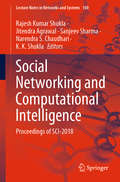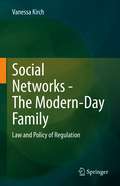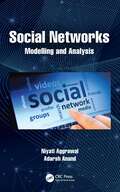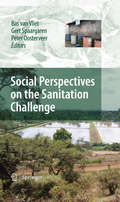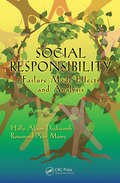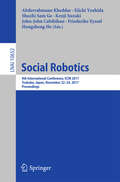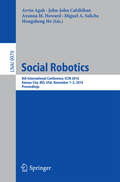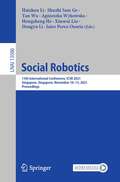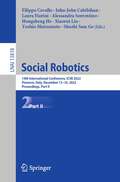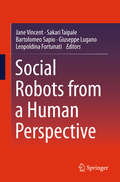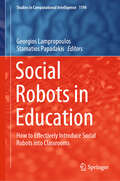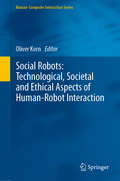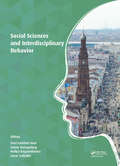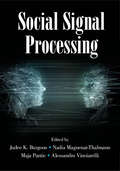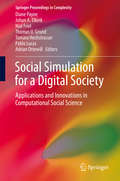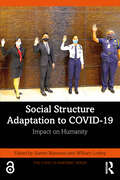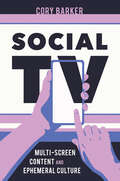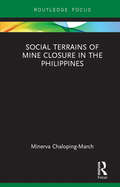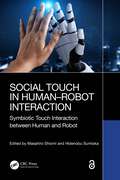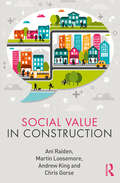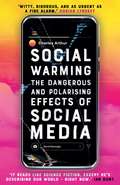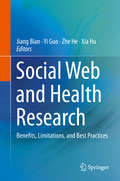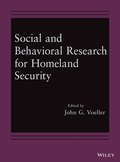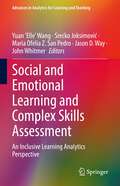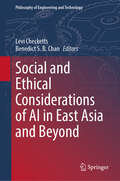- Table View
- List View
Social Networking and Computational Intelligence: Proceedings of SCI-2018 (Lecture Notes in Networks and Systems #100)
by Narendra S. Chaudhari Rajesh Kumar Shukla Jitendra Agrawal Sanjeev Sharma K. K. ShuklaThis book presents a selection of revised and extended versions of the best papers from the First International Conference on Social Networking and Computational Intelligence (SCI-2018), held in Bhopal, India, from October 5 to 6, 2018. It discusses recent advances in scientific developments and applications in these areas.
Social Networks - The Modern-Day Family: Law and Policy of Regulation
by Vanessa KirchSocial networks have created a plethora of problems regarding privacy and the protection of personal data. The use of social networks has become a key concern of legal scholars, policy-makers and the operators as well as users of those social networks. This pathbreaking book highlights the importance of privacy in the context of today's new electronic communication technologies as it presents conflicting claims to protect national and international security, the freedom of the Internet and economic considerations. Using the New Haven School of Jurisprudence's intellectual framework, the author presents the applicable law on privacy and social media in international and comparative perspective, focusing on the United States, the European Union and its General Data Protection Regulation of 2018 as well as Germany, the United Kingdom and Latin America. The book appraises the law in place, discusses alternatives and presents recommendations in pursuit of a public order of human dignity.
Social Networks: Modelling and Analysis (Advanced Research in Reliability and System Assurance Engineering)
by Adarsh Anand Niyati AggrawalThe goal of this book is to provide a reference for applications of mathematical modelling in social media and related network analysis and offer a theoretically sound background with adequate suggestions for better decision-making. Social Networks: Modelling and Analysis provides the essential knowledge of network analysis applicable to real-world data, with examples from today's most popular social networks such as Facebook, Twitter, Instagram, YouTube, etc. The book provides basic notation and terminology used in social media and its network science. It covers the analysis of statistics for social network analysis such as degree distribution, centrality, clustering coefficient, diameter, and path length. The ranking of the pages using rank algorithms such as Page Rank and HITS are also discussed. Written as a reference this book is for engineering and management students, research scientists, as well as academicians involved in complex networks, mathematical sciences, and marketing research.
Social Perspectives on the Sanitation Challenge
by Gert Spaargaren Peter Oosterveer Bas Van VlietThis collection presents a timely collection of social scientific papers dealing with innovative sanitation issues and concepts, perceptions and decision-making support. It comprises a valuable resource for political scientists, environmental engineers and urban planners involved in the study, design and implementation of sanitation projects worldwide and whose work relates to meeting the ambitious Millennium Development Goal of halving, by 2015, the number of people without sustainable access to safe drinking water and basic sanitation. In developed countries the sanitation challenge is to initiate a transition from strongly centralized, water-based infrastructure regimes towards more sustainable, source-separation oriented, sanitation regimes. This calls for social scientific research and demonstration on different levels and scales, including concept development, institutional learning and governance building. In the developing world the sanitation challenge is to provide sanitation services to the poor and the very poor, without compromising on sustainability. New configurations employing the best practices of sanitation technology and management for rural and urban contexts are needed. The sanitation challenge in both worlds is to go beyond traditional dichotomies between 'small, appropriate' and 'modern/advanced' technologies and to develop rural and urban sanitation with a mix of scales, strategies, technologies, payment systems and decision-making structures, that better fit the physical and human systems for which they are designed. This volume is unique in its presentation of social scientific research findings from urban planners, sociologists, economists, political scientists and environmental engineers who are involved in international sanitation research and implementation. Theoretically the volume include insights from Science and Technology Studies, Environmental Sociology and Urban Studies. Its empirical scope stretches from sanitation projects in Western Europe to Sub-Saharan Africa.
Social Responsibility: Failure Mode Effects and Analysis
by Holly Alison Duckworth Rosemond Ann MooreWith stock market swings due to unethical behavior, fuel price escalation due to increased demand, and climate disasters due to global warming, operating in a socially responsible manner is quickly moving from the realm of a nice idea to a business imperative. Taking a continuous improvement approach to social responsibility, Social Respo
Social Robotics
by Shuzhi Sam Ge Kenji Suzuki John-John Cabibihan Hongsheng He Abderrahmane Kheddar Eiichi Yoshida Friederike EysselThis book constitutes the refereed proceedings of the 4th International Conference on Social Robotics, ICSR 2012, held in Chengdu, China, in October 2012. The 66 revised full papers were carefully reviewed and selected from numerous submissions. The papers are organized in topical sections on affective and cognitive sciences for socially interactive robots, situated interaction and embodiment, robots to assist the elderly and persons with disabilities, social acceptance of robots and their impact to the society, artificial empathy, HRI through non-verbal communication and control, social telepresence robots, embodiments and networks, interaction and collaboration among robots, humans and environment, human augmentation, rehabilitation, and medical robots I and II.
Social Robotics
by Arvin Agah John-John Cabibihan Ayanna M. Howard Miguel A. Salichs Hongsheng HeThis book constitutes the refereed proceedings of the 8th International Conference on Social Robotics, ICSR 2016, held in Kansas City, MO, USA, in November 2016. The 98 revised full papers presented were carefully reviewed and selected from 107 submissions. The theme of the 2016 conference is Sociorobotics: Design and implementation of social behaviors of robots interacting with each other and humans. In addition to technical sessions, ICSR 2016 included three workshops: The Synthetic Method in Social Robotics (SMSR 2016), Social Robots: A Tool to Advance Interventions for Autism, and Using Social Robots to Improve the Quality of Life in the Elderly.
Social Robotics: 13th International Conference, ICSR 2021, Singapore, Singapore, November 10–13, 2021, Proceedings (Lecture Notes in Computer Science #13086)
by Shuzhi Sam Ge Yan Wu Hongsheng He Haizhou Li Agnieszka Wykowska Xiaorui Liu Dongyu Li Jairo Perez-OsorioThis book constitutes the refereed proceedings of the 13th International Conference on Social Robotics, ICSR 2021, held in Singapore, Singapore, in November 2021. The conference was held as a hybrid event.The 64 full papers and 15 short papers presented were carefully reviewed and selected from 114 submissions. The conference presents topics on humans and intelligent robots and on the integration of robots into the fabric of our society. The theme of the 2021 edition was “Robotics in our everyday lives”, emphasizing on the increasing importance of robotics in human daily living.
Social Robotics: 14th International Conference, ICSR 2022, Florence, Italy, December 13-16, 2022, Proceedings (Lecture Notes In Computer Science Series #13818)
by Shuzhi Sam Ge John-John Cabibihan Hongsheng He Filippo Cavallo Xiaorui Liu Laura Fiorini Alessandra Sorrentino Yoshio Matsumoto<p>The two-volume set LNAI 13817 and 13818 constitutes the refereed proceedings of the 14th International Conference on Social Robotics, ICSR 2022, which took place in Florence, Italy, in December 2022.<p> <p>The 111 papers presented in the proceedings set were carefully reviewed and selected from 143 submissions. The contributions were organized in topical sections as follows: Social robot navigation and interaction capabilities (voice, tactile); Social robot perception and control capabilities; Investigating non verbal interaction with Social robots; Foster attention and engagement strategies in social robots; Special Session 1: Social Robotics Driven by Intelligent Perception and Endogenous Emotion-Motivation Core; Special Session 2: Adaptive behavioral models of robotic systems based on brain-inspired AI cognitive architectures; Advanced HRI capabilities for interacting with children; Social robots as advanced educational tool; Social robot applications in clinical and assistive scenarios; Collaborative social robots through dynamic game; Design and evaluate user’s robot perception and acceptance; Ethics, gender & trust in social robotics.<p>
Social Robots from a Human Perspective
by Bartolomeo Sapio Jane Vincent Sakari Taipale Giuseppe Lugano Leopoldina FortunatiThis book presents a comprehensive overview of the human dimension of social robots by discussing both transnational features and national peculiarities. Addressing several issues that explore the human side of social robots, this book investigates what a social robot is and how we might come to think about social robots in the different areas of everyday life. Organized around three sections that deal with Perceptions and Attitudes to Social Robots, Human Interaction with Social Robots, and Social Robots in Everyday Life, it explores the idea that even if the challenges of robot technologies can be overcome from a technological perspective, the question remains as to what kind of machine we want to have and use in our daily lives. Lessons learned from previous widely adopted technologies, such as smartphones, indicate that robot technologies could potentially be absorbed into the everyday lives of humans in such a way that it is the human that determines the human-machine interaction. In a similar way to how today's information and communication technologies were initially designed for professional/industrial use, but were soon commercialized for the mass market and then personalized by humans in the course of daily practice, the use of social robots is now facing the same revolution of 'domestication. ' In the context of this transformation, which involves the profound embedding of robots in everyday life, the 'human' aspect of social robots will play a major part. This book sheds new light on this highly topical issue, one of the central subjects that will be taught and studied at universities worldwide and that will be discussed widely, publicly and repeatedly in the near future.
Social Robots in Education: How to Effectively Introduce Social Robots into Classrooms (Studies in Computational Intelligence #1194)
by Stamatios Papadakis Georgios LampropoulosThis book focuses on recent advances in the field of social robots and their integration in education. It elaborates on the progressive evolution of human-robot interaction and educational robotics, the emergence of digital pedagogy, and the implementation of personalized learning methodologies. The book also examines the use of artificial intelligence (AI) in education through the lenses of social robots. Hence, the book offers an overview of recent research into the adoption, integration, advancements, and impact of social robots and AI in education and presents guidelines and suggestions on how to integrate them in classrooms. Specifically, the book: Provides an in-depth overview of social robots and their use in education. Presents the advances of social robots and AI in education. Showcases innovative solutions and outcomes of integrating social robots in classrooms. Discusses the challenges, benefits, and future research directions of using social robots and AI in education.
Social Robots: Technological, Societal And Ethical Aspects Of Human-robot Interaction (Human–Computer Interaction Series)
by Oliver KornSocial robots not only work with humans in collaborative workspaces – we meet them in shopping malls and even more personal settings like health and care. Does this imply they should become more human, able to interpret and adequately respond to human emotions? Do we want them to help elderly people? Do we want them to support us when we are old ourselves? Do we want them to just clean and keep things orderly – or would we accept them helping us to go to the toilet, or even feed us if we suffer from Parkinson’s disease? The answers to these questions differ from person to person. They depend on cultural background, personal experiences – but probably most of all on the robot in question. This book covers the phenomenon of social robots from the historic roots to today’s best practices and future perspectives. To achieve this, we used a hands-on, interdisciplinary approach, incorporating findings from computer scientists, engineers, designers, psychologists, doctors, nurses, historians and many more. The book also covers a vast spectrum of applications, from collaborative industrial work over education to sales. Especially for developments with a high societal impact like robots in health and care settings, the authors discuss not only technology, design and usage but also ethical aspects. Thus this book creates both a compendium and a guideline, helping to navigate the design space for future developments in social robotics.
Social Sciences and Interdisciplinary Behavior: The 4th International Congress on Interdisciplinary Behavior and Social Science (ICIBSoS 2015), Kazan Federal University, Kazan, Russia, 22-23 October 2015 & Arya Duta hotel, Jakarta, Indonesia, 07–08 November 2015
by Ford Lumban Gaol, Fonny Hutagalung, Nailya Bagautdinova & Lenar SafiullinSocial Sciences and Interdisciplinary Behavior contains papers that were originally presented at the 4th International Congress on Interdisciplinary Behavior and Social Science 2015 (ICIBSoS 2015), held 22-23 October 2015 at The Institute of Management, Economics and Finance of the Kazan Federal University, Kazan, Russia and 7-8 November 2015 in Arya Duta Hotel, Jakarta, Indonesia. The contributions deal with various interdisciplinary research topics, particularly in the fields of social sciences, education, economics and arts. The papers focus especially on such topics as language, cultural studies, economics, behavior studies, political sciences, media and communication, psychology and human development.
Social Signal Processing
by Nadia Magnenat-Thalmann Judee K. Burgoon Alessandro Vinciarelli Maja Pantic"Social Signal Processing is the first book to cover all aspects of the modeling, automated detection, analysis, and synthesis of nonverbal behavior in human-human and human-machine interactions. Authoritative surveys address conceptual foundations, machine analysis and synthesis of social signal processing, and applications. Foundational topics include affect perception and interpersonal coordination in communication; later chapters cover technologies for automatic detection and understanding such as computational paralinguistics and facial expression analysis and for the generation of artificial social signals such as social robots and artificial agents. The final section covers a broad spectrum of applications based on social signal processing in healthcare, deception detection, and digital cities, including detection of developmental diseases and analysis of small groups. Each chapter offers a basic introduction to its topic, accessible to students and other newcomers, and then outlines challenges and future perspectives for the benefit of experienced researchers and practitioners in the field"--
Social Simulation for a Digital Society: Applications and Innovations in Computational Social Science (Springer Proceedings in Complexity)
by Johan A. Elkink Diane Payne Nial Friel Thomas U. Grund Tamara Hochstrasser Pablo Lucas Adrian Ottewill“Social Simulation for a Digital Society” provides a cross-section of state-of-the-art research in social simulation and computational social science. With the availability of big data and faster computing power, the social sciences are undergoing a tremendous transformation. Research in computational social sciences has received considerable attention in the last few years, with advances in a wide range of methodologies and applications. Areas of application of computational methods range from the study of opinion and information dynamics in social networks, the formal modeling of resource use, the study of social conflict and cooperation to the development of cognitive models for social simulation and many more. This volume is based on the Social Simulation Conference of 2017 in Dublin and includes applications from across the social sciences, providing the reader with a demonstration of the highly versatile research in social simulation, with a particular focus on public policy relevance in a digital society. Chapters in the book include contributions to the methodology of simulation-based research, theoretical and philosophical considerations, as well as applied work. This book will appeal to students and researchers in the field.
Social Structure Adaptation to COVID-19: Impact on Humanity (The COVID-19 Pandemic Series)
by Suresh Nanwani William LoxleySocial Structure Adaptation to COVID-19 offers global, interdisciplinary perspectives that examine how the COVID-19 pandemic has altered the development trajectory of schools, public health, the workforce, and technology adoption. It explores social themes in society, economy, policy, and culture and draws on a social framework to describe key functions of societal adaptation to the pandemic.Edited by Suresh Nanwani and William Loxley, the volume is grounded in the study of system components and their objectives to improve overall well-being given the ill effects of the COVID-19 pandemic. Chapters explore interconnected social networks and how sectors restructured themselves to stabilize or transform society. International contributors from 20 countries offer case studies that highlight key themes including personal connectivity, societal equality, well-being, big data, and national resilience. They predict how impactful the pandemic might be in reshaping the future and assess how the COVID-19 pandemic has affected school system shutdown, public health collapse, business closures, public policy failure, and technology-driven social media acceleration.Offering insights into how institutions and sectors work together in times of crisis, and how COVID-19 has restructured social behavior, Social Structure Adaptation to COVID-19 will be valuable reading for scholars and students of sociology, political science, anthropology, comparative international development, psychology, and education. It will also be of interest to policymakers concerned with education, work and organizations, and media and technology.The Open Access version of this book, available at www.taylorfrancis.com, has been made available under a Creative Commons Attribution-Non Commercial-No Derivatives (CC-BY-NC-ND) 4.0 international license.
Social TV: Multi-Screen Content and Ephemeral Culture
by Cory BarkerWinner of the 2023 SCMS Media Industries Scholarly Interest Group Outstanding Book Award sponsored by the Center for Entertainment & Media IndustriesOn March 15, 2011, Donald Trump changed television forever. The Comedy Central Roast of Trump was the first major live broadcast to place a hashtag in the corner of the screen to encourage real-time reactions on Twitter, generating more than 25,000 tweets and making the broadcast the most-watched Roast in Comedy Central history. The #trumproast initiative personified the media and tech industries’ utopian vision for a multi-screen and communal live TV experience. In Social TV: Multi-Screen Content and Ephemeral Culture, author Cory Barker reveals how the US television industry promised—but failed to deliver—a social media revolution in the 2010s to combat the imminent threat of on-demand streaming video. Barker examines the rise and fall of Social TV across press coverage, corporate documents, and an array of digital ephemera. He demonstrates that, despite the talk of disruption, the movement merely aimed to exploit social media to reinforce the value of live TV in the modern attention economy. Case studies from broadcast networks to tech start-ups uncover a persistent focus on community that aimed to monetize consumer behavior in a transitionary industry period. To trace these unfulfilled promises and flopped ideas, Barker draws upon a unique mix of personal Social TV experiences and curated archives of material that were intentionally marginalized amid pivots to the next big thing. Yet in placing this now-forgotten material in recent historical context, Social TV shows how the era altered how the industry pursues audiences. Multi-screen campaigns have shifted away from a focus on live TV and toward all-day “content” streams. The legacy of Social TV, then, is the further embedding of media and promotional material onto every screen and into every moment of life.
Social Terrains of Mine Closure in the Philippines (Routledge Studies of the Extractive Industries and Sustainable Development)
by Minerva Chaloping MarchThe current discourse on mine closure is informed predominantly by industry and corporate perspectives and predicated by experiences of mainly mining companies that are based in developed countries where necessary planning frameworks and regulatory requirements are well-established. Mine closure planning, well promoted and accepted as good business practice in the global minerals industry, has been primarily technical and precautionary both in approach and focus. Planning, modelling and monitoring strategies incorporate comprehensive and detailed elements such as properties inherent in landforms, climate, geology, flora and fauna, among others. However, locality-based concerns that revolve around resource access and tenure, rights and entitlements tied to locality and indigeneity, labour recruitment, and other non-bio-physical elements are hardly examined. Any mine closure program that omits these elements is deficient and therefore ineffective. Social Terrains of Mine Closure in the Philippines, based on ethnographic research and archival materials, presents the varying experiences of three mines to demonstrate that the mine closure process is an intense locus for competition and compromises among various social actors. This book offers key messages for understanding the complex socio-cultural, economic, political, and business realities that make up the social terrains of mine closure, and will be of great interest to students and researchers in development studies, community development, business studies, anthropology, and sociology. It will also appeal to those working in the global minerals sectors and NGOs that engage in development work and advocacy for responsible mining.
Social Touch in Human–Robot Interaction: Symbiotic touch interaction between human and robot
by Masahiro Shiomi Hidenobu SumiokaIn this book for researchers and students, editors Shiomi and Sumioka bring together contributions from researchers working on the CREST project at ATR Deep Interaction Laboratories, a world leader in social robotics, to comprehensively describe robot touch systems from hardware to applications.Appropriate touch from robots to humans is essential for social robots, but achieving this requires various solutions at every stage of the touch process. Through this book, readers will gain an understanding of the needs, essential systems and communication cues, behaviour designs, and real‑world issues for social touch applications. This book compiles and updates technical and empirical research that was previously scattered throughout the literature into a single volume. Through individually authored chapters addressing various elements of ATR’s CREST project, this book tackles key areas where understanding is needed to realize acceptable touch interaction, including pre‑touch interaction, interaction design for touching and being touched, behaviour changes caused by touch interaction, and applications of social touch interaction. It introduces a touch sensor and robots developed by the authors, including several touch‑related behaviours and design policies. This approach will enable readers to easily apply this knowledge to their own social robotics programs. This book is invaluable for anyone who wishes to understand and develop social robots that physically interact with people.It is most beneficial for researchers and upper undergraduate and graduate students in the fields of human–robot/agent/computer interaction and social touch interaction and those in the broader fields of engineering, computer science, and cognitive science.
Social Value in Construction
by Andrew King Chris Gorse Martin Loosemore Ani RaidenWhile the concept of social value is not new, recent interest in social value in construction has grown because of new social procurement legislation around the world and an increasing acceptance of the need to ensure construction projects provide social value, rather than simply economic value. Despite this growing recognition, literature and professional guidance on the subject is hard to find. This is the first book looking at social value in construction and it sets the agenda by asking and answering important questions like: How is the construction industry developing and supporting social enterprise and social value and for who? How and when is the industry recording and measuring social value and its effect? Which organisations are doing things well and what can we learn from their experiences? What can industry players do together to consolidate efforts and drive improvements? What are the key challenges in the field and what does the future look like? Drawing on a variety of professional and academic experiences and disciplines, the authors present global perspectives and lay the foundations for creating social value in the construction industry. This timely book makes use of real-life case studies and examples of best practice to demonstrate how innovative companies can utilise contemporary research to create social value through their projects. It is time the construction industry viewed community involvement and corporate social responsibility as an opportunity rather than a risk, and this is the book that shows the industry how. This is essential reading for all professionals in the construction, engineering, architecture and built environment sector. In particular, project managers, clients, contract managers, quantity surveyors, CSR and HR personnel will gain a lot from reading this book.
Social Warming: The Dangerous and Polarising Effects of Social Media
by Charles ArthurNobody meant for this to happen. Facebook didn&’t mean to facilitate a genocide. Twitter didn&’t want to be used to harass women. YouTube never planned to radicalise young men. But with billions of users, these platforms need only tweak their algorithms to generate more &‘engagement&’. In so doing, they bring unrest to previously settled communities and erode our relationships. Social warming has happened gradually – as a by-product of our preposterously convenient digital existence. But the gradual deterioration of our attitudes and behaviour on- and offline – this vicious cycle of anger and outrage – is real. And it can be corrected. Here&’s how.
Social Web and Health Research: Benefits, Limitations, and Best Practices
by Yi Guo Jiang Bian Zhe He Xia HuThis book presents state-of-the-art research methods, results, and applications in social media and health research. It aims to help readers better understand the different aspects of using social web platforms in health research. Throughout the chapters, the benefits, limitations, and best practices of using a variety of social web platforms in health research are discussed with concrete use cases. This is an ideal book for biomedical researchers, clinicians, and health consumers (including patients) who are interested in learning how social web platforms impact health and healthcare research.
Social and Behavioral Research for Homeland Security
by John G. VoellerSocial and Behavioral Research for Homeland Security features articles from the Wiley Handbook of Science and Technology for Homeland Security covering social and psychological aspects of terrorism and counterterrorism efforts from different perspectives. First, it examines the roots of terrorism; second, it explores the consequences of terrorism; then communication, training, and learning development of responders and the public in situations of terror attacks, are discussed.
Social and Emotional Learning and Complex Skills Assessment: An Inclusive Learning Analytics Perspective (Advances in Analytics for Learning and Teaching)
by Yuan ‘Elle’ Wang Srećko Joksimović Maria Ofelia Z. San Pedro Jason D. Way John WhitmerIn this book, we primarily focus on studies that provide objective, unobtrusive, and innovative measures (e.g., indirect measures, content analysis, or analysis of trace data) of SEL skills (e.g., collaboration, creativity, persistence), relying primarily on learning analytics methods and approaches that would potentially allow for expanding the assessment of SEL skills and competencies at scale. What makes the position of learning analytics pivotal in this endeavor to redefine measurement of SEL skills are constant changes and advancements in learning environments and the quality and quantity of data collected about learners and the process of learning. Contemporary learning environments that utilize virtual and augmented reality to enhance learning opportunities accommodate for designing tasks and activities that allow learners to elicit behaviors (either in face-to-face or online context) not being captured in traditional educational settings. Novel insights provided in the book span across diverse types of learning contexts and learner populations. Specifically, the book addresses relevant and emerging theories and frameworks (in various disciplines such as education, psychology, or workforce) that inform assessments of SEL skills and competencies. In so doing, the book maps the landscape of the novel learning analytics methods and approaches, along with their application in the SEL assessment for K-12 learners as well as adult learners. Critical to the notion of the SEL assessment are data sources. In that sense, the book outlines where and how data related to learners' 21st century skills and competencies can be measured and collected. Linking theory to data, the book further discusses tools and methods that are being used to operationalize SEL and link relevant skills and competencies with cognitive assessment. Finally, the book addresses aspects of generalizability and applicability, showing promising approaches for translating research findings into actionable insights that would inform various stakeholders (e.g., learners, instructors, administrators, policy makers).
Social and Ethical Considerations of AI in East Asia and Beyond (Philosophy of Engineering and Technology #47)
by Benedict S. B. Chan Levi CheckettsThis book is a global reflection on disparate religious and philosophical approaches to questions of AI and the particular ways these questions affect East Asian societies. These chapters originate from a conference held at Hong Kong Baptist University in April 2023 on “Ethical and Social Issues in AI: East Asia and Beyond.” Sections cover Confucianist, Daoist, and Christian reflections on AI ethics. Chapters on broad theoretical questions that AI poses are included as well as those addressing issues in applied AI ethics. This volume appeals to students and researchers working across cultures and traditions on the philosophy of AI technology.
